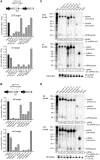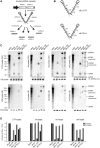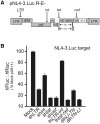Deriving four functional anti-HIV siRNAs from a single Pol III-generated transcript comprising two adjacent long hairpin RNA precursors
- PMID: 20525791
- PMCID: PMC2965221
- DOI: 10.1093/nar/gkq460
Deriving four functional anti-HIV siRNAs from a single Pol III-generated transcript comprising two adjacent long hairpin RNA precursors
Abstract
Several different approaches exist to generate expressed RNA interference (RNAi) precursors for multiple target inhibition, a strategy referred to as combinatorial (co)RNAi. One such approach makes use of RNA Pol III-expressed long hairpin RNAs (lhRNAs), which are processed by Dicer to generate multiple unique short interfering siRNA effectors. However, because of inefficient intracellular Dicer processing, lhRNA duplexes have been limited to generating two independent effective siRNA species. In this study, we describe a novel strategy whereby four separate anti-HIV siRNAs were generated from a single RNA Pol III-expressed transcript. Two optimized lhRNAs, each comprising two active anti-HIV siRNAs, were placed in tandem to form a double long hairpin (dlhRNA) expression cassette, which encodes four unique and effective siRNA sequences. Processing of the 3' position lhRNA was more variable but effective multiple processing was possible by manipulating the order of the siRNA-encoding sequences. Importantly, unlike shRNAs, Pol III-expressed dlhRNAs did not compete with endogenous and exogenous microRNAs to disrupt the RNAi pathway. The versatility of expressed lhRNAs is greatly expanded and we provide a mechanism for generating transcripts with modular lhRNAs motifs that contribute to improved coRNAi.
Figures





Similar articles
-
The efficacy of generating three independent anti-HIV-1 siRNAs from a single U6 RNA Pol III-expressed long hairpin RNA.PLoS One. 2008 Jul 2;3(7):e2602. doi: 10.1371/journal.pone.0002602. PLoS One. 2008. PMID: 18596982 Free PMC article.
-
The inhibitory efficacy of RNA POL III-expressed long hairpin RNAs targeted to untranslated regions of the HIV-1 5' long terminal repeat.Oligonucleotides. 2007 Winter;17(4):419-31. doi: 10.1089/oli.2007.0095. Oligonucleotides. 2007. PMID: 17896874
-
Effective Pol III-expressed long hairpin RNAs targeted to multiple unique sites of HIV-1.Methods Mol Biol. 2010;629:159-74. doi: 10.1007/978-1-60761-657-3_11. Methods Mol Biol. 2010. PMID: 20387149
-
Artificial miRNAs as therapeutic tools: Challenges and opportunities.Wiley Interdiscip Rev RNA. 2021 Jul;12(4):e1640. doi: 10.1002/wrna.1640. Epub 2021 Jan 1. Wiley Interdiscip Rev RNA. 2021. PMID: 33386705 Review.
-
Approaches for chemically synthesized siRNA and vector-mediated RNAi.FEBS Lett. 2005 Oct 31;579(26):5974-81. doi: 10.1016/j.febslet.2005.08.070. Epub 2005 Sep 20. FEBS Lett. 2005. PMID: 16199038 Review.
Cited by
-
Efficacy Analysis of Combinatorial siRNAs against HIV Derived from One Double Hairpin RNA Precursor.Front Microbiol. 2017 Aug 29;8:1651. doi: 10.3389/fmicb.2017.01651. eCollection 2017. Front Microbiol. 2017. PMID: 28900421 Free PMC article.
-
RNA Interference Therapies for an HIV-1 Functional Cure.Viruses. 2017 Dec 27;10(1):8. doi: 10.3390/v10010008. Viruses. 2017. PMID: 29280961 Free PMC article. Review.
-
Silencing of Parkinson's disease-associated genes with artificial mirtron mimics of miR-1224.Nucleic Acids Res. 2012 Oct;40(19):9863-75. doi: 10.1093/nar/gks712. Epub 2012 Jul 30. Nucleic Acids Res. 2012. PMID: 22848108 Free PMC article.
-
Robust RNAi enhancement via human Argonaute-2 overexpression from plasmids, viral vectors and cell lines.Nucleic Acids Res. 2013 Nov;41(21):e199. doi: 10.1093/nar/gkt836. Epub 2013 Sep 17. Nucleic Acids Res. 2013. PMID: 24049077 Free PMC article.
-
Recent advances in RNAi-based strategies for therapy and prevention of HIV-1/AIDS.Adv Drug Deliv Rev. 2016 Aug 1;103:174-186. doi: 10.1016/j.addr.2016.03.005. Epub 2016 Mar 21. Adv Drug Deliv Rev. 2016. PMID: 27013255 Free PMC article. Review.
References
-
- Henry SD, van der Wegen P, Metselaar HJ, Tilanus HW, Scholte BJ, van der Laan LJ. Simultaneous targeting of HCV replication and viral binding with a single lentiviral vector containing multiple RNA interference expression cassettes. Mol. Ther. 2006;14:485–493. - PubMed
-
- ter Brake O, Konstantinova P, Ceylan M, Berkhout B. Silencing of HIV-1 with RNA interference: a multiple shRNA approach. Mol. Ther. 2006;14:883–892. - PubMed
Publication types
MeSH terms
Substances
LinkOut - more resources
Full Text Sources
Other Literature Sources
Medical

